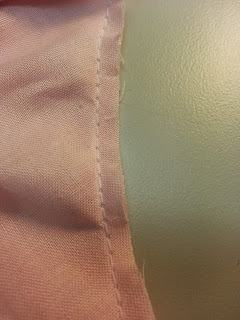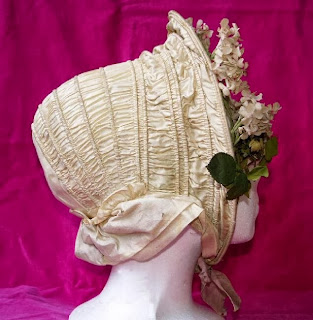Bias Binding
This tutorial is done in the prospective of hand sewing. You can of course do this on the machine, but you may not have as nice of results.
You will need approximately 2 yards of bias tape. You can either use the video tutorial from my blog to make your own bias tape, or you can use pre made bias tape.
If you are using your own bias tape, you will need to pre fold one side at 1/2 an inch. Like I say in the video, the bonnet will be thick, and it's hard to accurately predict how wide the bias tape will need to be to have an accurate 1/2 an inch of bias tape on either side of the bonnet. That being said, if you pre fold the exterior side at 1/2 an inch (that being the side that is most offten seen) and by eye, fold the interior side as close as possible to 1/2 an inch, you will get a more pleasing result.
I use a metal pressing ruler to do this.
You will apply bias tape with a staggered back-stitch. The difference between back-stitch and a staggered back-stitch is instead of starting your next stitch at the base of the last stitch, begin your stitch halfway between your new stitch and your last....thus staggered.
Your needles grab should be about 1/4 of an inch, the finished stitch will be half that length about 1/8 of an inch.
The most difficult areas to apply will be the corners. There are 4 outside corners and 2 inside corners.
Your needles grab should be about 1/4 of an inch, the finished stitch will be half that length about 1/8 of an inch.
The most difficult areas to apply will be the corners. There are 4 outside corners and 2 inside corners.
Outside Corners
You will be applying the bias tape to the bonnets exterior to start with.
Put a Running Stitch through the area of bias tape that will be applied to the bonnets outside corner. Pull the thread taught and arrange the bias tape to the outside corner so that the fabric is smooth. Again, use the staggered back-stitch to sew the bias tape to the bonnet.
Inside Corner
You will start the inside corner by placing the bias binding along one side of the corner. Measure 1/2 an inch to the interior and 1/2 an inch from the bias edge. You should have a perfect 45 degree angle from the bonnets inside corner edge.
Stagger back-stitch back to your last completed outside corner.
Now make a 45 degree fold in the bias tape and line up the bias tape to the bonnets edge. Starting at the inside corner, made sure that there are no folds in the bias tape, start your staggered back-stitches and work onward to the next outside corner.
Interior Bias Binding.
Once the exterior binding is finished , roll the bias tape over the bonnets edge and fold the bias tape leaving 1/2 of an inch bias tape on the interior side.
Pin and fold all the bias tape on the interior side. Smooth as you, go, create small pleats at outside corners, and make a 45 degree fold at the inside corners.
You will use a slip stitch to attach the bias binding on the interior.
That concludes the View A tutorial.






















































